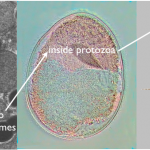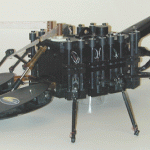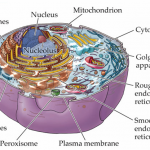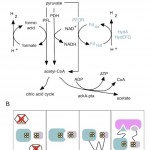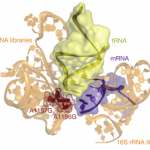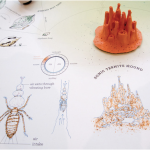
As you can probably imagine, there are a lot of very interesting things that pop up when you have a google alert for "synthetic biology." Here is today's special find: a short dubstep song about synthetic biology by Dysoniq, featuring a voice talking about computer chips for your brain from this video, an interesting hour-long BBC presentation about intelligent robots (thanks again, Google!).
Synthetic BiologybyDysoniq
I got a lot of interesting responses to my post about DIYbio and how modeling innovation in biotech on computer hacker culture may lead to a science that is less "democratized" than what is being proposed. My friend Adam pointed me to Jaron Lanier's work criticizing the "open" and "free" culture movements online as both unfair and leading to cultural stagnation. While I don't agree with all of Lanier's arguments about the prospects of an open digital culture, he makes a lot of really important points that resonate with my feelings about the future of science based on the open online model, in…
My two great thesis project loves are hydrogen and symbiosis, and as such, the recent news of a multicellular organism that lives in a completely oxygen free environment and gets its energy from hydrogenosomes instead of mitochondria is totally fascinating.
Hydrogenosomes are organelles that are evolutionarily related to mitochondria. Mitochondria generate energy for the cell by transferring electrons pulled off of sugars molecules to oxygen (this is why we breathe oxygen). The energy from this electron motion is transferred to the production of ATP, the energy currency of the cell, through…
An interesting paper in BioEssays last month looks at the potential future of xenobiology, totally orthologous biological systems made out of synthetic nucleotide and amino acid bases, new cells that use XNA instead of DNA. The author, Markus Schmidt, argues that while the design of such systems current poses a difficult technological challenge to researchers in synthetic biology, that xenobiological systems will enable a "genetic firewall" between natural and designed organisms, creating a built-in measure of biosafety.
This is something I've argued for before, in reference to creating new…
Last week's issue of Nature focused on the progress (or lack thereof) in genomics and related fields since the Human Genome Project (HGP) was completed ten years ago. In many ways, the era of genomics has yet to fulfill many of the promises made twenty years ago, but the investment in science and technology has at the same time made a valuable impact on many fields in basic science. Understanding this recent history of the genomics bubble is crucial to how we approach current science and technology investments in areas such as personal genomics and importantly, synthetic biology.
In a…
Because of my recent interest in autonomous, biologically inspired robots, my friend Tami sent me some fascinating links about designs and concepts for future flesh eating robots.
From New Scientist, furniture that captures vermin and uses the biomass to power fuel cells that run small electronics:
From Wired, Human corpse powered robots being developed by the Defense Department:
From the file marked "Evidently, many scientists have never seen even one scary sci-fi movie": The Defense Department is funding research into battlefield robots that power themselves by eating human corpses. What…
Another Hydrocalypse Industries original production, the Beard-ome presents imaginary work on the genomics of the beard. What's lying beneath your beard?
Cellularity is a new project by James King, a speculative designer working on biotechnology and interaction design. The project focuses on the potential future of smart pharmaceuticals, drug molecules surrounded by membranes that over time as technology advances may come to more and more closely resemble actually living things. He proposes a cellularity scale from totally non-living to really alive artificial cells. This quantification of "aliveness" in a way is something that may need to be done if some of the proposals of synthetic biology come to fruition. When does a membrane surrounding…
Happy Ada Lovelace Day! Today we blog to celebrate women in technology and science and remember Ada Lovelace, the woman considered to have written the world's first computer program back in the 1840's.
So to celebrate, here's a clip of an interview with Rita Levi-Montalcini, one of my favorite Sassy Bitches of Scienceâ¢. At age 100, she is the oldest living Nobel laureate, sharp as a tack, still working, and a sassy dresser to boot. Her story is incredible and inspiring (especially in light of what I wrote about yesterday on DIYbio, oppression, and opportunity). Turned away from her position…
I read R.C. Lewontin's Biology as Ideology: The Doctrine of DNA over the weekend and was struck in particular by one line in his wonderful diatribe against biological determinism and reductionism:
"Intellectuals in their self-flattering wish-fulfillment say that knowledge is power, but the truth is that knowledge further empowers only those who have or can acquire the power to use it."
This is something that was really hard to read at first, especially as someone who is overeducated and clearly spends a lot of time thinking about educating other people about science. But I realized that it…
Synthetic biology deliberately equates genetic networks to electronic circuits, cells to machines, organisms to factories. In synthetic biology, every living can be thought of as a cyborg, a living machine that can be manipulated, changed to meet our needs, parts swapped in and out like a computer. Some projects in synthetic biology and biologically inspired engineering hope to bring the analogy a step further, combining biological and actual electronic and mechanical components into a single engineered unit, with the goal of essentially making tiny autonomous cyborgs.
There are a lot of…
Carboxysomes are small compartments inside photosynthetic bacteria where the machinery for capturing carbon dioxide is concentrated. You can see carboxysomes and their characteristic virus-like shape when you look at slices of these bacteria under an electron microscope:
Until recently, no one had looked at carboxysomes under the microscope in cells that were still alive. My labmates Dave and Bruno developed a way to label carboxysomes with fluorescent proteins and track them under a microscope as the cells grow, and their amazing paper in Science details some of the fascinating systems they…
The fight over genetically modified foods, whether they're safe, healthy, good for the environment, or just plain "unnatural," has been going on for a long time now. Most people in the scientific community agree that genetic modification in general is a good thing, able to create crops that need less water, less fertilizer, less pesticide, or that contain extra vitamins and nutrients that are otherwise difficult to come by in certain parts of the world. Many would also argue that fighting against such life-saving, often environmentally sustainable modifications is a sign of an ignorant anti-…
Animal cells are made up of many smaller membrane-bound compartments called organelles that perform highly specialized functions necessary for life. Incredibly, several of these organelles have been shown to be evolutionarily related to free-living bacteria, captured and incorporated inside a larger cell billions of years ago in a complex mutually beneficial relationship, known as endosymbiosis (a partnership between two species where one of the species is inside the other). The mitochondria that power our cells, generating energy by breaking down sugars are in fact relatives of regular old…
My paper, "Insulation of a synthetic hydrogen metabolism circuit in bacteria" just came out in the Journal of Biological Engineering! And it's open access!
We designed a metabolic circuit in bacteria that produces hydrogen (a potentially useful fuel) from natural precursors in the cell. The proteins in our synthetic pathway work to make hydrogen by transferring high-energy electrons from pyruvate, a common metabolite, to protons that are freely floating in the watery cytoplasm. The electrons transfer between the proteins through quantum-mechanical tunneling, which makes hydrogenases and…
My labmates and I love Lady Gaga. Like, love love love. Enough to make a parody fan video of Bad Romance. It is my pleasure to present to you "Lab Romance", a production of Hydrocalypse Industries. Enjoy!
Lyrics after the jump!
ø⸨°º¤ø⸸âø¤º°¨¸âø¤º°¨ ¨°º¤øâ¸LADYâø¤º°¨ âø¤º°¨ GAGA `°º¤ø¨°º¤ø⸸âø¤º°¨¸âø¤º°¨ ¨°º¤ø
Music by Lady Gaga, lyrics by Tami Lieberman and Jake Wintermute, performed by Jake Wintermute, editing by me and Patrick Boyle, dancing by the Silver Lab.
Oh-oh-oh-oh-oooh!
Oh-oh-oooh-oh-oh!
Caught in a lab romance…
Some of the responses to my post about synthetically expanding the genetic code have highlighted some of the weaknesses in my argument about the safety of using a different genetic code. Namely, that "life finds a way", that we can't really ever know for sure what will happen when we release a synthetic organism in the wild, or how natural selection will act on them. The science fiction scenarios where engineered organisms escape, break out of the designed restrictions on their growth and take over in new and terrifying ways are compelling, frightening, and instructive for thinking about…
Here's my first little editing project for my documentary film class. A day in the lab, but much much faster paced.
Almost every living thing shares an identical genetic code, with three nucleic acids in an RNA sequence coding for a single amino acid in the translated protein sequence. While there are 64 three-letter RNA sequences, there are only 20 amino acids and degeneracy in the code allows some amino acids to be coded by multiple codons. Chemists and synthetic biologists in the past few years have been working to expand this genetic code, with unnatural nucleotides that can be incorporated into DNA and RNA sequences and unnatural amino acids that can expand the chemical functionality of proteins.…
The future potential of synthetic biology is usually discussed in terms of applications in fields like medicine, food science, and the environment. Genetically engineered life forms are being designed to make medicines cheaply, to target tumor cells, to make more nutritious food, or to make agricultural plants that are easier to grow with less of an environmental impact, to clean up pollution or produce sustainable biofuels. What if synthetic biology systems were instead designed for use in culture or entertainment?
David Benqué, a student in the Design Interactions program at the Royal…
